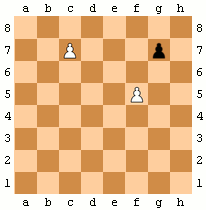
Both moves were introduced to the ruleset of chess between the 13th and 16th centuries.It is taught together with the rest of the rules of the game. It doesn’t really fit into the regular set of rules, so why does it even exist in the first place?Įssentially, en passant is a direct response to the double-advance of the pawn, which is possible on its first move. Beautiful! Why Does En Passant Even Exist?Įn Passant is a bit of a random move in chess. Our pawn now delivers checkmate, as the black king has no legal moves left. Lucky for us, the black pawn advances two squares, giving us the right to capture it en passant. You can see Black has no legal move except moving his pawn on the g-file. Here’s a cool checkmate for you: Checkmating by Capturing En PassantĪdmittedly, checkmating your opponent by capturing en passant is probably a once-in-a-chess-career occasion. As always with chess strategy: it depends on the position. However, there are countless examples where it doesn’t make sense to capture en passant, even though you are technically allowed to.

In this case, it would make sense for White to capture en passant for three reasons: Black Just Played Pawn to b5, should you capture en passant with your pawn on a5? Should You Capture En Passant? It’s not like capturing en passant is inherently bad, but – as always in chess – you need to evaluate if a certain move improves or worsens your position ⚖️.

We can now capture the pawn as if it had only moved forward one square.Įven though en passant is a pretty nifty move, don’t be tempted to blindly capture en passant when given the chance.The enemy pawn advanced two squares, placing it directly next to our pawn.Our pawn is on the 5th rank, with an enemy pawn on the 7th rank (and yet to make its first move) on a horizontally adjacent file.Capturing en passant could look something like this: White Captures the Advancing Black Pawn “En Passant” Meaning, you lose your right to capture en passant if you do not immediately exercise it ❌. However, this special move is only allowed on the turn immediately after the enemy pawn’s two-square advance. If (and only if) these three rules are met, you can immediately capture the enemy’s pawn as if it only moved forward one square. The enemy pawn moved two squares on the previous move.Both pawns must occupy adjacent files (i.Both pawns must occupy the same rank (i.There are three rules that need to be met to be allowed to capture a pawn en passant:
#En passant rule how to#
Let’s break it down so you actually understand how to capture en passant. That’s exactly how FIDE describes en passant in their official rulebook of chess. This capture is only legal on the move following this advance and is called an ‘en passant’ capture.” “A pawn attacking a square crossed by an opponent’s pawn which has advanced two squares in one move from its original square may capture this opponent’s pawn as though the latter had been moved only one square. Ready for a boring description of en passant? Here you go:

En passant is the only time where the capturing piece does not end up in the square it captured the enemy piece from.


 0 kommentar(er)
0 kommentar(er)
